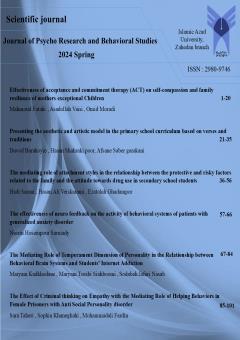The mediating role of attachment styles in the relationship between the protective and risky factors related to the family and the attitude towards drug use in secondary school students.
Subject Areas : Psychology
Hadi Sarani
1
,
Hasan Ali Veiskarami
2
,
Ezatolah Ghadampor
3
![]()
1 - PhD Student, Department of Educational Psychology, Lorestan University, Khorramabad, Iran.
2 - Associate Professor, Department of Psychology, Faculty of Literature and Humanities, Lorestan University, Khorramabad, Iran.
3 - Professor, Department of Psychology, Faculty of Literature and Humanities, Lorestan University, Khorramabad, Iran.
Keywords: Attachment style, attitude towards addiction, family, Protective and risky factors,
Abstract :
The purpose of this study was to examine how family factors (religious beliefs, socio-economic base, cultural beliefs, and parenting style) affected the attitudes of Khorram Abad City upper secondary school students regarding drug use, with identity styles and attachment styles serving as mediators. The method of this research was a correlation from the Path analysis. All Khorram Abad city upper secondary school students who were enrolled in the school year 2022–2023 made up the research population. 380 students made up the sample size and were chosen using the method of stratified sampling. The measurement tools include common questionnaires of religious beliefs Bahrami (2009), socioeconomic base, by Ghodratnama (1993), parenting styles, by Baumrind (2004), attachment styles, by Collins and Reed (1990), and attitude towards addiction, by Nazari (2010), as well as a researcher-made questionnaire of indigenous cultural beliefs. At the end, the results showed that the direct path of parenting style (P < 0.001, β = 0.51), religious beliefs (P < 0.001, β = 0.48), local cultural beliefs (P < 0.001, (β=0.65) and the path of socio-economic base to the attitude towards drug use (P<0.001, β=0.67) is significant. Also, the direct path of parenting style (P < 0.001, β = 0.78), religious beliefs to (P < 0.001, β = 0.62), local cultural beliefs (P < 0.001, 0.57) =β), economic-social base (P<0.001, β=0.47) to attachment styles and the direct path of attachment styles to attitude to drug use (P<0.001, 0.47) β), are significant. Also, the lower and upper limits of the


